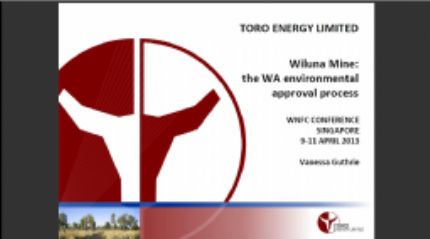
Identifies Regional Uranium Alteration System in McArthur Basin, Northern Territory
Adelaide, Nov 13, 2012 AEST (ABN Newswire) - Toro Energy Limited ( ASX:TOE) is pleased to report the results of reconnaissance soil and rockchip sampling in the McArthur Basin project of the Northern Territory. This work has been focussed on establishing the characteristics of airborne radiometric anomalies and the uranium potential of breccia pipes in the region.
ASX:TOE) is pleased to report the results of reconnaissance soil and rockchip sampling in the McArthur Basin project of the Northern Territory. This work has been focussed on establishing the characteristics of airborne radiometric anomalies and the uranium potential of breccia pipes in the region.
Key points:
- Recognition of a large-scale geochemical alteration system in the northern part of Toro's 100% owned Karns tenement, which directly mirrors an intense airborne radiometric anomaly (Figure 1).
- Up to 280 ppm U3O8 and 1360 ppm Cu in rockchips of quartz sandstone that is elsewhere chemically 'bland' (Figure 2). Coincident anomalous Ag, As and Pd up to10 times background.
- Interpreted to represent the broad surface expression of fertile breccia pipes in the underlying Gold Creek Volcanics. Analogous with the Arizona Strip Uranium Province that comprise a cluster of high grade deposits that previously supported significant mining in the USA.
- Running Creek-Stanton breccia pipes also show anomalous uranium at surface associated with copper mineralisation suggesting a genetic connection to the stratigraphically higher Karns system.
Background:
Toro originally applied for the Karns (EL27429), Running Creek (EL28567) and Selby tenements (ELA29636) shown on Figure 1 in the McArthur Basin of the NT, due to the geological similarity to the Arizona Strip in the USA, where uranium has been mined from multi-commodity breccia pipes for over 50 years. The individual deposits of the Arizona Strip, whilst relatively small tonnage at less than10 Mlb U3O8, are high grade (>0.5% U3O8) and occur in a dense cluster that is able to support sustainable mining operations.
Toro believes there is a high-probability of similar targets in the McArthur Basin because breccia pipe clusters are already well known in the region (e.g., Redbank, Running Creek and Stanton pipe sets; Figure 1) and have supported copper mining over the last 20 years. The geological and geochemical commonalities with the Arizona Strip are remarkable.
Toro flew detailed 100m-spaced magnetics and radiometrics over Karns in 2011, highlighting a number of large high-amplitude anomalies in the total count and uranium channels (Figure 2). These anomalies also dominate the regional datasets.
Methodology and Results:
During August 2012, Toro collected 32 rockchip, 70 lag and 112 multi-fraction soil samples along orientation lines on the Karns and Running Creek tenements. The samples were submitted to ALS Laboratories for various digestions and chemical analyses (see Appendix 1 for summary table of rockchip results). Results from rockchip samples show that U, Cu, Ag, As and Pd are consistently elevated within a large high-amplitude radiometric anomaly overlying the exposed basal sandstone of the Karns Dolomite in Toro's Karns tenement (Figure 2).
U3O8 is up to 280ppm (ave 80ppm) and Cu is up to 1360ppm (ave 320 ppm), whilst Ag, As and Pd are generally 10 times background. Scintillometer readings throughout the anomaly area are also uniformly 10 times background. The sandstone generally contains less than 1% P2O5 and over 80% SiO2, consistent with field observations of a sublithic to quartzose character. Secondary copper minerals are locally developed on fracture surfaces (Figure 3).
Anomalous samples were collected over a stratigraphic thickness exceeding 10m. These results are considered extremely anomalous, as beyond the radiometric anomaly this sandstone has a uniform background range of only 1-5ppm U3O8 and 5-10ppm Cu, consistent with oxidised sandstones globally. Rockchips also indicate that the same element suite is anomalous at the upper margins of breccia pipes sampled on Toro's Running Creek tenement (Stout, Saltlick and Felix). This suggests a close genetic connection to the stratigraphically-higher Karns system.
Similarly, orientation soil samples indicate common geochemical trends in both tenements, utilising both partial digest and full digest techniques. Uranium is 5-10 times background, as are elements such as Ag, Au, As, Cu, Co, Mo, Pt and Pd. Additionally, the ratio of pathfinder isotopes Pb208/Pb206 and Pb207/Pb206 indicate a radiogenic source of Pb in the system, consistent with a buried uranium parent source. Heavy versus light rare earth elements ("REEs") display a zonation typical of hydrothermal alteration systems. This has encouraged Toro to submit a further set of 97 partial digest soil samples from Karns for analysis, covering outlying radiometric anomalies, including a small P-U-Zn occurrence in the south.
Interpretation:
The distribution of anomalous uranium and other pathfinder elements in rockchips and soil samples at Karns faithfully mirrors the spatial signature of the airborne radiometrics (Figure 2). Toro is therefore confident that the large (11 km2) radiometric anomaly in the northern part of the Karns tenement reflects a broad alteration halo associated with breccia pipes in the underlying fertile Gold Creek Volcanics. Based on the physical dimensions and concentration of uranium in rockchips, the alteration halo has a substantial inventory of uranium in itself, more than sufficient to potentially promote formation of economic uranium mineralisation. Further 'plumes' are interpreted over similar large radiometric anomalies in eastern Karns and within the recently acquired Selby tenement (ELA29636; Figure 1), which incorporates the historic Selby P-U-Cu-REE prospects. Grades at these prospects reach 1120ppm U3O8 and 0.81% Cu, hosted within phosphatic sandstone. The Karns Dolomite also hosts a number of base metals occ
urrences in the area, including the 'Mississippi Valley style' Thor prospect (Zn-Pb-Ag).
Based on the vertical zonation of metals in the Arizona Strip model, Toro predict that uranium should be concentrated stratigraphically above base metals within the McArthur breccia pipes. On this basis, it appears that this model has not yet been tested in the region, as drilling has concentrated on the exposed lower parts of the breccia pipes where there is obvious copper mineralisation at Redbank and Stanton.
Toro proposes to undertake further soil and rockchips sampling at Karns and, when granted, the Selby tenement. Ground electromagnetics has been used successfully in the Arizona Strip to identify individual breccia pipes under cover and Toro believes it will also be successful in the McArthur Basin in defining drill targets. The development of further geophysics and an initial reconnaissance drilling program will be considered after this work.
View the complete Toro Energy announcement including Figures at the link below:
http://media.abnnewswire.net/media/en/docs/ASX-TOE-706087.pdf
Contact
Toro Energy Limited
T: +61-8-8132-5600
F: +61-8-8362-6655
WWW: www.toroenergy.com.au
| ||
|









